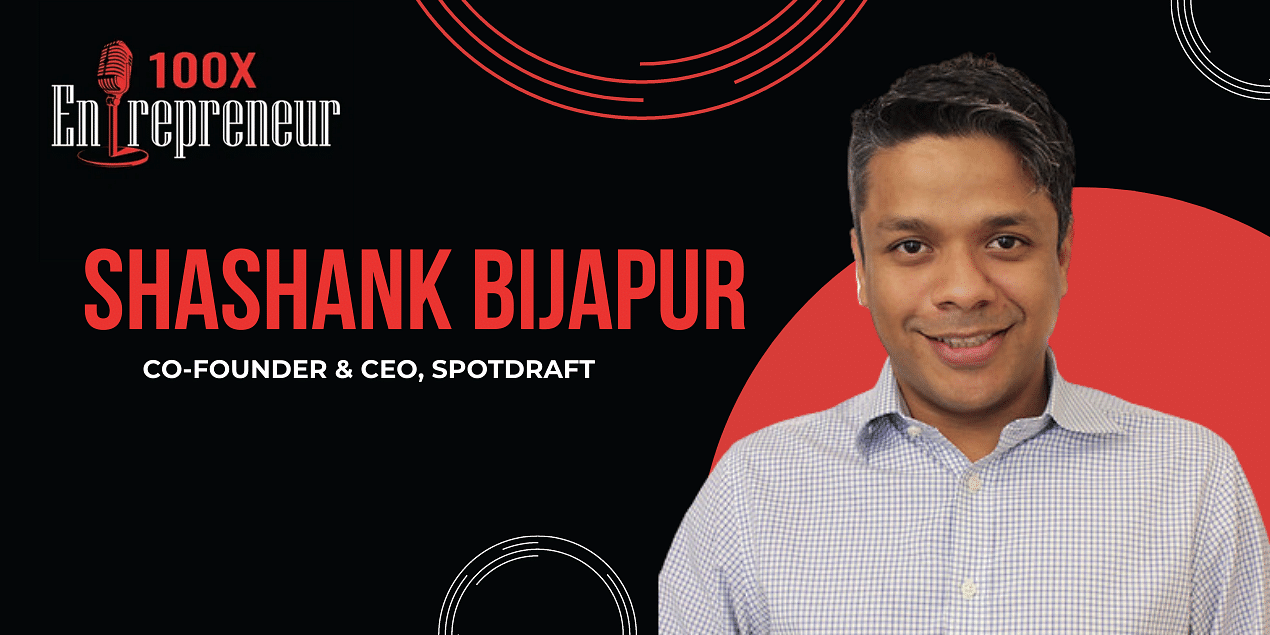Finding the right mix to be a successful entrepreneur does not happen overnight. It takes time, effort, and understanding.
SpotDraft Founder Shashank Bijapur had his fair time to understand his entrepreneurial calling and to grow his startup.
In a conversation with Siddhartha Ahluwalia, Founder and Host of 100x Entrepreneur, Shashank says, “I don’t think any startup today can start an enterprise-first business and really find product-market fit in the first year or two years. That journey is very hard. It is not scalable and repeatable.”
As a founder of a contract automation SaaS startup, Shashank says the idea of your product is very different from the idea/requirement of a product that the company wants.
“And that means you’re building everything all over again – perhaps not reusable pieces, for clients over and over again. That’s just a very difficult journey. If you look at the SaaS playbook that we see these days, you always start mid-market now and much more enterprise as you grow.”
Finding inspiration
A lawyer by education, Shashank was working with a Wall Street law firm, White & Case, in New York. One day, he came across a new story about Elon Musk building cars that would drive themselves. That, he says, was when it hit him.
“Cars [were] driving themselves and I [was] still here, copying pasting words in a contract. There’s something that needed to change. So I went around looking for specific software and automation tools built for lawyers and there were none,” he recalls.
Shashank, who had an entrepreneurial bent of mind, always wanted to be an entrepreneur. This was in 2015-16, where India’s startup growth journey had started. He wanted to be a part of the booming startup culture in India and thus came down to India to start SpotDraft along with two other people.
Finding the product-market fit
Initially, the idea of growth to Shashank meant an increase in the number of clients. He soon learnt about the need for product-market fit when someone he met used the word PMF.
“One of the key elements of product-market fit is you’re able to replicate the use case and the outcome of the software. For example, in our case, repeatedly for a given problem statement within a given market. None of that existed for us, then. We did not have a repeatable sales process, we did not have a repeatable product that was there. It was almost like a custom-built software that we had to build for each new client,” he explains.
Shashank found an opportunity when he understood about the limited product options the mid-market segment then had in terms of contract management. “We started building SpotDraft for the mid-market right after that and started seeing some extremely phenomenal growth.”
Recalling some of his initial mistakes in entrepreneurship, Shashank says, “In the beginning, we did not focus on ‘active selling’ and distribution. We focused way too much on listening to the customer and building for the customer, and not building for the problem that the customer had.”
“We never questioned the customer as to why you need this. I felt like we spent about close to a year in that space where we were just going and speaking to customers, building for them, and not being able to reuse anything, and not having a set of team members who were delivering the value of the product to others externally.”
But, with unicorns as some of its earlier customers (including Whatfix, Chargebee, Unacademy, Cred, PhonePe), SpotDraft grew – and how. It now has close to 100 customers, of which 50 percent are in India and 50 percent are abroad.
To know more, listen to the entire podcast here
01:19 – Starting SpotDraft and meeting his wife for the 1st time
04:51 – First few years of struggle
07:28 – Timeline & SpotDraft’s journey
10:34 – Switch of TG: From enterprise to startups
12:58 – Early customers: Unacademy and Chargebee amongst others
14:36 – Hiring A+ talent: Referrals from existing employees
17:01 – Mistakes in 0 to 1 Journey
22:18 – Competitive edge over large competitors
25:23 – “Let’s get SpotDrafted.”


![Read more about the article [Funding alert] Asirvad Microfinance raises $15M from WorldBusiness Capital Inc](https://blog.digitalsevaa.com/wp-content/uploads/2021/05/Imagewf2p-1607509774638-300x150.jpg)







